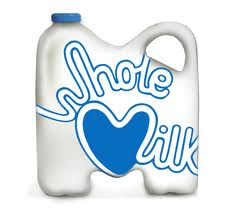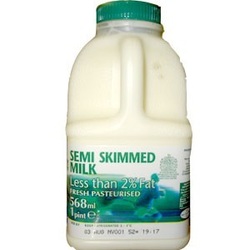 By Heather If you are on a calorie-controlled diet, then one easy way to cut your calorie consumption is to switch from whole milk to a lower fat variety such as semi-skimmed milk. If you are not counting the calories and living an active life, or if you are a growing child, then whole milk – typically around 3.5-4% fat – is a great source of nutrition. What is the difference between whole milk and semi-skimmed milk in terms of processing? Whole milk is more or less straight out of the cow in terms of fat content; all supermarket bought milk is pasteurised to kill germs and homogenised to ensure an even consistency. However, different cow breeds produce milk with slightly different fat contents. So a Jersey cow produces really creamy milk (yum!) compared to a Holstein. Even the season or type of food the farmer gives the cow can change the fat content. So to ensure a standard fat content of 4% the milk is processed. The processing is a way of separating all the fat (cream) from the non-fat (skim) and then returning the fat to the skim in specified amounts according to the desired milk. So less cream is returned to the skim when producing semi-skimmed milk compared to whole milk. What is the difference between whole milk and semi-skimmed milk in terms of fat content? The fat content of whole milk is 4%. For semi-skimmed the fat content is around 2%. You can also get 1% milk, which contains 1% fat, and skimmed milk which is virtually fat-free. Fat Content in Different Milk:
 Is the fat in milk bad fat? Fat has a bad press, but milk is highly nutritious and a good source of fat. The fat in milk is made up of several different fatty acids. The majority of these are saturated fatty acids which you may have heard about. Much official guidance from health agencies advises limiting saturated fat intake because of the link to heart disease. However milk also contains other fatty acids such as mono- and polyunsaturates.
 What are the advantages of whole milk? Whole milk is a good source of energy for growing children or young adults with high energy needs. It is also energy dense, so the elderly may use whole milk to get a good portion of their calorie intake. What are the disadvantages of whole milk? Whole milk does have the highest fat content, and contains 21-23 more calories per 100ml than 1% semi-skimmed. So if you are on a calorie controlled diet or trying to lose weight, you may want to swap whole milk for a lower calorie milk since over time, these calories are significant. What milk should one choose? Your choice of milk should be guided by your individual tastes as well as your health goals. If you cannot tell the difference in taste between the different milk and you are restricting calories, semi-skimmed or lower fat milk is a good option. If you are living a physically active life and not drinking milk to excess, you can enjoy whole milk.  Although your personal finances and your business success are my primary interest, I believe you only operate at peak efficiency when you're fit and healthy. If you feel good, it filters through to your work. To help you with that, click for your free ebook: The Quick Guide to Sexy
0 Comments
Leave a Reply. |
By Heather
|
Heather Katsonga-Woodward, a massive personal finance fanatic.
** All views expressed are my own and not those of any employer, past or present. ** Please get professional advice before re-arranging your personal finances.
 RSS Feed
RSS Feed


